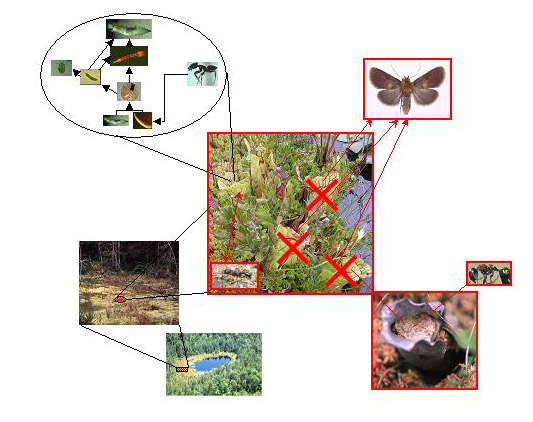You are here
Spatial dimension of species interactions
Ecologists have long recognized that coexistence of interacting species depends on a diversity of separate, but linked habitats. Most models of species coexistence treat these habitat "patches" as unchanging elements of the landscape, but in reality, they are constantly changing in size and shape. The structure and dynamics of the food webs that inhabit them both control and depend on these changes. In a five-year (2006-2011) collaborative project, Nick Gotelli (University of Vermont) and I are seeking to understand how species interactions change the spatial distribution of dynamic habitat patches across the landscape, and to determine how food webs are structured within and among these patches. The experimental system for this five-year research project is the Sarracenia "microecosystem": the northern pitcher-plant Sarracenia purpurea; the unique food web of bacteria, protozoa, rotifers, mites, and fly larvae that live within its rainwater-filled leaves; three species of bog-inhabiting ants that are the primary prey for this carnivorous plant; and larvae of the pitcher-plant moth, Exyra fax, which cut and drain pitchers and remove food web habitat. Results from surveys of 50 New England bogs and three field experiments conducted at the Harvard Forest Long-Term Ecological Research site will parameterize a simulation model to predict changes in spatial structure of ant, moth, and plant populations, and the structure and composition of the aquatic food web associated with the plant.
models of species coexistence treat these habitat "patches" as unchanging elements of the landscape, but in reality, they are constantly changing in size and shape. The structure and dynamics of the food webs that inhabit them both control and depend on these changes. In a five-year (2006-2011) collaborative project, Nick Gotelli (University of Vermont) and I are seeking to understand how species interactions change the spatial distribution of dynamic habitat patches across the landscape, and to determine how food webs are structured within and among these patches. The experimental system for this five-year research project is the Sarracenia "microecosystem": the northern pitcher-plant Sarracenia purpurea; the unique food web of bacteria, protozoa, rotifers, mites, and fly larvae that live within its rainwater-filled leaves; three species of bog-inhabiting ants that are the primary prey for this carnivorous plant; and larvae of the pitcher-plant moth, Exyra fax, which cut and drain pitchers and remove food web habitat. Results from surveys of 50 New England bogs and three field experiments conducted at the Harvard Forest Long-Term Ecological Research site will parameterize a simulation model to predict changes in spatial structure of ant, moth, and plant populations, and the structure and composition of the aquatic food web associated with the plant.
This work is funded by the U.S. National Science Foundation, through collaborative awards 0541680 and 0541936.

